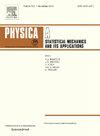Travel time delay model with lane management policy for connected automated vehicles
IF 3.1
3区 物理与天体物理
Q2 PHYSICS, MULTIDISCIPLINARY
Physica A: Statistical Mechanics and its Applications
Pub Date : 2025-07-31
DOI:10.1016/j.physa.2025.130873
引用次数: 0
Abstract
This paper proposes a general framework of the travel time delay model with multi-lane road segments to consider different lane management policies (LMPs) for connected automated vehicles (CAVs). First, two LMPs for CAVs and a baseline lane policy are introduced. Second, the car-following modes and their proportions in CAVs dedicated lanes (CDLs) and normal lanes (NLs) with different LMPs are analyzed, respectively. Then, the multi-lane travel time delay model with different LMPs is derived based on the point queue (P-Q) model, and the relevant properties are proposed and proved. Finally, multiple parameters, such as the traffic demand, the penetration rate (PR) of CAVs, and the number of lanes and CDLs, are analyzed to assess their impact on the optimal split ratio, average reduced delay and optimal PR interval based on the proposed model, and the optimal number of CDLs and optimal LMP in different scenarios are given. Results show that (1) the optimal split ratio is always 0 until the PR reaches a critical value. Subsequently, the optimal split ratio increases with the PR; (2) only when the demand exceeds the critical demand and the PR is in the optimal PR interval, the (C, M) and (C, H) policies are possible to reduce the average delay; (3) compared with baseline lane policy, the optimal CDL settings can reduce the average delay by 100 % at maximum; (4) the optimal LMP is the baseline lane policy when the PR or the demand is low, while the optimal LMP is (C, M) policy when both the PR and the demand are high. This work provides insights into the impact of LMPs on travel time delay and helps decide the optimal number of CDLs and the optimal LMP.
具有车道管理策略的网联自动驾驶车辆行驶时滞模型
针对网联自动驾驶汽车不同的车道管理策略,提出了一种多车道路段行驶时滞模型的一般框架。首先,介绍了自动驾驶汽车的两个lmp和一个基线车道策略。其次,分别分析了不同LMPs的自动驾驶汽车专用车道(CDLs)和普通车道(NLs)的跟车模式及其比例。然后,基于点队列(P-Q)模型,导出了具有不同LMPs的多车道行驶时延模型,并提出并证明了相关性质。最后,分析了交通需求、自动驾驶汽车渗透率(PR)、车道数和CDLs数等多个参数对基于该模型的最优分割比、平均减少延迟和最优PR间隔的影响,给出了不同场景下的最优CDLs数和最优LMP。结果表明:(1)在PR达到临界值之前,最优分割比始终为0。随后,最优劈裂比随PR的增大而增大;(2)只有当需求超过临界需求且PR处于最优PR区间时,(C, M)和(C, H)策略才有可能降低平均延迟;(3)与基线车道策略相比,最优CDL设置最大可使平均延迟降低100 %;(4)当PR或需求较低时,最优LMP为基线车道策略;当PR和需求均较高时,最优LMP为(C, M)策略。研究结果揭示了LMP对交通延误的影响,有助于确定最优LMP和最优cdl数量。
本文章由计算机程序翻译,如有差异,请以英文原文为准。
求助全文
约1分钟内获得全文
求助全文
来源期刊
CiteScore
7.20
自引率
9.10%
发文量
852
审稿时长
6.6 months
期刊介绍:
Physica A: Statistical Mechanics and its Applications
Recognized by the European Physical Society
Physica A publishes research in the field of statistical mechanics and its applications.
Statistical mechanics sets out to explain the behaviour of macroscopic systems by studying the statistical properties of their microscopic constituents.
Applications of the techniques of statistical mechanics are widespread, and include: applications to physical systems such as solids, liquids and gases; applications to chemical and biological systems (colloids, interfaces, complex fluids, polymers and biopolymers, cell physics); and other interdisciplinary applications to for instance biological, economical and sociological systems.

 求助内容:
求助内容: 应助结果提醒方式:
应助结果提醒方式:


